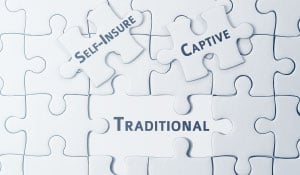A Guide to Choosing The Right Insurance Strategy for Your Business
January 26th, 2024
3 min read
Topics:
January 26th, 2024
3 min read

The world of business insurance can feel overwhelming. With so many options—traditional insurance, self-insurance, and captive insurance—how do you know which is the best fit for your company? This guide breaks down the pros and cons of each type, helping you make an informed decision that aligns with your business's needs and financial goals.
| Aspect | Traditional Insurance | Self-Insurance | Captive Insurance |
| Cost | Fixed Premiums, potentially high | Variable costs, potentially lower | Initial high setup costs, long-term savings |
| Risk Management | Limited control, insurer manages risk | Full control over risk management | Customized risk management to company needs |
| Flexibility | Low, predetermined policies | High, customized to business needs | high, customizable policies |
| Control | Insurer controls policies and claims | Business controls policies and claims | Full control over policies and claims |
| Transparency | Low, limited insight into cost breakdown | High, full insight into costs | High, transparent financial management |
| Regulatory Requirements | Complies with insurer's regulations | Complies with self-insurance regulations | Must meet captive specific regulations |
| Benefits | Simple, predictable, easy to manage | Potential cost savings, control | Significant cost savings, customization |
| Fronting Carrier | Not required | Not required | Typically required for regulatory compliance |
Traditional insurance involves paying a fixed premium to an insurance company that assumes the risk on behalf of the business. This option offers simplicity and predictability, with the insurer managing all aspects of risk and claims. However, it often comes with high premiums and limited control over policies and claims processes.
Self-insurance allows a business to set aside funds to cover potential losses, rather than paying premiums to an insurer. This approach provides full control over risk management and can lead to cost savings. However, it requires careful planning, significant financial resources, and a thorough understanding of regulatory requirements.
Captive insurance involves creating a wholly-owned insurance subsidiary to insure the risks of the parent company or group. This structure offers significant cost savings, tailored risk management, and full control over policies and claims. A fronting carrier is typically required to issue policies on behalf of the captive, ensuring regulatory compliance and facilitating claims processing. While captive insurance involves high initial setup costs and regulatory compliance, the long-term benefits often outweigh these challenges.
You might be wondering if captives are right for your business. Take your captive assessment to see if captive insurers are right for your business.
What is traditional insurance? Traditional insurance involves paying premiums to an insurance company, which assumes the risk and manages policies and claims.
What is self-insurance? Self-insurance means a business sets aside funds to cover potential losses instead of paying premiums to an insurer, offering control and potential cost savings.
What is captive insurance? Captive insurance involves creating a wholly-owned subsidiary to insure the parent company’s risks, offering significant control, cost savings, and customization.
What are the cost differences between traditional, self-insurance, and captive insurance? Traditional insurance has fixed, often high premiums. Self-insurance has variable costs based on actual losses. Captive insurance involves high initial setup costs with potential long-term savings.
How do these options manage risk? Traditional insurance involves the insurer managing risk. Self-insurance offers full control over risk management. Captive insurance provides tailored risk management specific to the parent company’s needs.
What are the regulatory requirements for these insurance options? Traditional insurance must comply with the insurer’s regulations. Self-insurance requires compliance with self-insurance regulations. Captive insurance must meet captive-specific regulations, often facilitated by a fronting carrier.
What is a fronting carrier and when is it needed? A fronting carrier is a licensed insurance company that issues policies on behalf of a captive insurer, ensuring regulatory compliance and facilitating claims processing. It is typically required for captive insurance.
Choosing the right insurance strategy for your business depends on your unique needs, resources, and risk profile. Traditional insurance offers simplicity and predictability, while self-insurance provides control and potential cost savings. Captive insurance offers significant long-term benefits through customized risk management and control.
By understanding the differences and benefits of each option, you can make an informed decision that aligns with your business goals and financial strategies. Use our captive insurance pricing calculator to look at how much you would need to invest and see how much your business can profit in a captive.
Warren, the president and founder of ReNu Insurance, shifted from being a commercial pilot to the insurance industry after 9/11. He applied his aviation safety and risk management skills to insurance, creating ReNu's captive insurance model. This approach cuts costs and turns insurance into a strategic asset. An authority in captive insurance with advanced certifications, Warren drives innovative risk management solutions. Under his leadership, ReNu Insurance sets new standards, offering practical and financially smart risk management. Warren Cleveland, ACI, CIC, AAI
Topics: